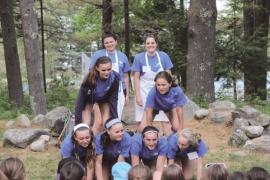Technology and camping? Hearing those two words together often sparks ire among camp management. “We don’t allow our kids to use techie toys!” you declare. Of course, unless you run a computer camp, that philosophy holds true. iPhones and tweets (except those of birds) have no place in kids’ lives near the woods, lake, or farm.
But camp owners and staff are discovering that practical technologies and tools can help them fill bunks and buses faster with quality campers, communicate better with staff and parents, and save thousands of dollars and hours each year.
The key word is, of course, practical. Technology for technology’s sake is pointless and distracting. Many “digital immigrants” (those of us born long before the Internet) struggle with the speed of technological change and the numerous options for systems, apps, and devices. How do you know what you really need versus what is the next cool trend? How do you embrace and incorporate digital tools into your marketing and operation, while reinforcing to your camp population that they need to unplug during camp season?
Here are some practical tips for integrating digital wisdom into your camp’s operations.
“Do As I Say . . . Not As I Do.”
Although technology may be strictly forbidden or restricted for campers during your program, the management and staff probably need digital media and devices to streamline and improve the quality of training, parent and staff communications, operations, and marketing. This overview touches on marketing; however, see my September/October 2012 Camping Magazine article, “The 24/7/365 Camp Community: Sitting around the Online Campfire,” for more specific marketing technologies.
If campers or staff question why you are carrying an iPad or wearing headphones while they cannot, simply explain that you are using technology to run the camp better and ensure their safety and fun. After all, the same principles apply to walkie-talkies or the fax machine in the camp office; only “adults in charge” usually have access.
Devise a Digital Plan
As you look to incorporate new, upgraded, and useful technologies into your camp or program operations, lay out a timeline and budget for “upgrading.” Do your home-work, comparison shop for features and price, and speak to experts. Your advisors may include other camp directors, business consultants, and vendors who can clearly explain the value of their recommendations in plain English.
Buying new technologies and systems can be like adopting a Great Dane puppy or leasing a gas-guzzling car. When you invest in a new system or tool, ask how often you’ll need to upgrade or maintain it and what level of skill is required. Many of us have heard horror stories of Web-based systems that cost thousands of dollars to keep updated over time or require a special code that only a handful of people know. Investigate the facts and consider both short- and long-term implications of your purchases.
The following is an overview of the various ways in which camps are using technology to deliver better program experiences. As you are developing your plan, you may use it as a checklist to ensure you don’t become a digital dinosaur.
Training
Digital media can be an extremely effective means of building a competent staff community and leadership skills.
Face-to-face training and season-long feedback is still considered essential, but how do you ensure that your staff has all the skills it needs? Web-based training programs like e-Institute courses, certificate trainings, and webinars in ACA’s Professional Development Center or on ExpertOnlineTraining.com deliver the “rock stars” of camp education to staff members’ laptops, tablets, and mobile de-vices wherever in the world they are.
Rather than squeezing training into a few days, online programs enable directors to start training immediately upon hire. (Look for programs with content that has been vetted through ACA’s Educational Endorsement Program® to ensure quality.) Staff can participate in training at their own pace and at times that are most convenient for them, and they can re-watch videos if they choose. In short, staff learn at their own pace and time and, therefore, may retain more. Content is kept up-to- date, and directors can even look at test results to see where each staff member is strong or weak and where additional training may be required. Directors are also able to fulfill their camp accreditation standards more knowledgably and ensure that staff members — even those overseas — are get-ting the same level and amount of pre- and in-season preparation.
Registration and Information Management
Systems for registration and keeping detailed camper and family records have migrated from paper to cloud-based tools, eliminating the need for forms, postage, copy machines, and file cabinets. Data can be accessed just as easily from a desktop, a laptop, or a smartphone.
When choosing or upgrading a system, ask yourself — and the management of the vendors you are considering — the following questions. In today’s digital world, the online customer experience is a huge part of your sales process, and the accuracy/accessibility of information is critical to camper safety. Know exactly what you’re buying and how to use it. For example:
- What types of information do I absolutely need to capture and store? How long do I need to keep this information and how much access will I need? Who else needs access?
- How easy is the system to use? For my-self? My staff? My camp parents?
- Will I need to go back to the development company each time I require editing, or will I be able to manage some of the maintenance myself? How much customizing can I do?
- What are all the costs involved? Now and later?
- How does this system integrate with other systems I use? • How much is the development company investing in new applications for the future? What are the plans for additions and changes? Do they look to their customers for input on enhancements and changes?
- Do you “click” with the management team at the vendor? Who will your day- to-day contact be? Avoid companies that speak in techie talk. You need to under-stand exactly what your investment in technology is getting you.
Speak to current users of the system as well as past clients who chose to part ways with the vendor. Former customers can often give you the best insights.
Communications
Technology, if used properly, can enable you to reach more people and specific people immediately, directly, and 24/7/365.
Telephones
Parents need to reach you and you need to reach parents and staff. Cloud-based phone systems (like Ring Central) enable you to receive messages from anywhere. Voice messages can be transmitted — as voice or text messages — immediately to your smartphone or other device. Next-generation mobile systems like MercurySend enable staff to deploy mass messages to mobile phones or highly targeted messages to specific groups (e.g., a text to a targeted list of parents of twelve- year-old day campers could remind them to pack lunch for a field trip).
Tablets
Some camps have invested in iPads or other tablets for their senior staff, who receive updated schedules and alerts from the main office through-out the day. Make sure your facility is wireless-friendly, otherwise message delivery can be spotty. If you purchase technology in bulk, you can negotiate deeply discounted pricing and deals on upgrades. But set strict policies for the use of devices, and make sure your insurance covers loss and breakage. Remember to take inventory at the end of the season, too. Or perhaps you may decide to “gift” a tablet or two to top staff members.
Other Communications Systems
A variety of technologies can ensure camper and staff safety. Installing GPS systems in camp vehicles and setting up central alert systems on premises can be important steps in making sure everyone in your program knows exactly where to go and what to do at all times.
Marketing Media
This topic could fill this entire publication, as new applications emerge weekly. Work with a marketing company that truly understands today’s balance between traditional and digital media and recommends what you really need — not just what they create or what is considered trendy.
Here are the primary digital media you should consider as you develop your 2014 marketing strategy:
- Web site.
- Social media strategy, including an air traffic control system and staff resources for managing the various sites.
- Digital assets, permission to use images, and a system for deploying and storing them. Digital assets are content and images such as:
- Blogs.
- Photos.
- Videos. Some new innovations include Vine (six-second streaming videos) and Vpak (which combines the traditional camp brochure with a wafer-thin, flat-screen TV).
- E-marketing strategy and systems.
- Online advertising.
- Mobile marketing.
- Search engine marketing and search engine optimization.
- A digital public relations plan.
Remember that your message and targeting are infinitely more important than the media. No matter which platforms, apps, or formats you use, your brand and how you deliver your points of difference in words and pictures are the most important aspects of a marketing communications plan.
Relax and Plug In
After reading all this, you may find your-self overwhelmed. The digital realm is changing so radically and rapidly that keeping up with it all may feel like another full-time job.
Approach the challenge the same way your campers tackle the climbing wall or getting up on water skis for the first time: Stay confident in your ability to learn a new skill and move slowly, steadily, and with commitment and optimism.
Start by creating that checklist of your 2014 technology goals, and even consider using a cloud-based system like Google Drive, Microsoft 365, or Wiggio to manage project tasks and accountabilities. Simple task lists like List Master or Remember the Milk can be downloaded to your tablet or other mobile device so you can set simple goals for yourself each day and week. Technology can not only be used to streamline your camp operations, it can be that “string around the finger” each day that helps you achieve your objectives!
Author’s note: Thank you to those who helped to provide insights for this article, including Chris Thurber, PhD; Sam Borek of Woodmont Day Camp; Drew Bitterman of Jeff Lake Camp; Eric Stein; Renee Flax; David Allen-Hughes of Camp Doodle; Peter Schiffrin; and Alyssa Trelstad. Photos on pages 64 and 65 courtesy of Camp Howe, Goshen, Massachusetts; Copley Family YMCA, San Diego, California; Manzano Mountain Retreat, Torreon, New Mexico; and Southwoods, Paradox, New York.
Nancy A. Shenker is founder/CEO of theONswitch, a boutique marketing company that combines traditional and social media. theONswitch works with a wide variety of camps, summer programs, and education businesses on developing marketing plans that include social media and creates Web sites and social media presence. Nancy is also a regular speaker at ACA’s national and tri- state conferences, and runs educational webinars, workshops, and one-on-one social media training. (And she is a former “camp mother!”) She can be reached at [email protected], via www.facebook.com/theonswitchmarketing and www.theonswitch.com. Or call her at 914.969.2900.
Originally published in the 2013 September/October Camping Magazine.


